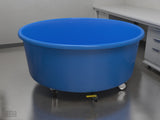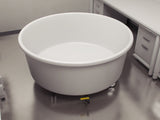The Morris Water Maze is a widely used behavioral task in neuroscience for studying spatial learning and memory. This test is based on the fact that an animal will try to escape a stressful situation or stimulus, which in this case is a large pool of water. The pool contains a small platform, either visible above the water level, or just below the surface of the water. This small platform allows the animals to escape the water and allows them to stand without the stress of swimming, and is designed with a mesh or grooved material that allows for easy handling. Pre-training occurs by introducing the location of the escape platform and using a platform that is visible above the water surface. On the following days, the actual test is performed, in which the platform is hidden beneath the water surface. To escape swimming in the water, the animal must remember the location of the escape platform using visual cues in the testing area, which requires use of hippocampal-dependent spatial reference memory, and this ability to remember the location of the platform can be affected by the administration of certain drugs or disease models.
The MWM was first used by Richard Morris at the University of St. Andrews in Scotland in the early 1980s. Since then, it has become one of the most widely used tools in behavioral neuroscience because of its easy of use and training, its many variations, and its ability to test various areas of brain function. Morris published a series of papers describing the maze and its evaluation of hippocampal-dependent learning over several years (Morris 1981, Morris 1982, Morris 1984, Morris 1986). The maze also gained popularity when it was used by Ian Whishaw’s group in Canada (Kolb et al. 1982, Kolb et al. 1983). Since these initial papers, the maze has been used to study various disease models, including endocrine abnormalities, strokes, Alzheimer’s disease, other neurodegenerative diseases, and their effects on learning and memory (Brandeis et al. 1989).









